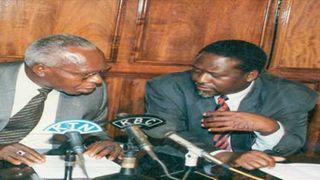
Mr Simeon Nyachae, then Finance minister, and Mr Raila Odinga, then Lang’ata MP, discuss clashes in Gucha, Migori and Trans Nzoia on March 7, 1998.
| File | Nation Media GroupNews
Premium
Why Nyachae and Raila hated each other’s guts
What you need to know:
- Nyachae blamed Odinga for blocking his Presidential bid through the famous “Kibaki Tosha” endorsement in 2002.
- The former Ford People leader worked day and night to derail Mr Odinga’s chances of being President in 2007.
In a country with competing political interests mostly drawn along tribal lines, the political differences between former Cabinet minister Simeon Nyachae and ODM leader Raila Odinga were legendary.
Whereas Nyachae blamed Odinga for blocking his Presidential bid through the famous “Kibaki Tosha” endorsement in 2002, the former Ford People leader worked day and night to derail Mr Odinga’s chances of being President in 2007.
After decades of enmity, the two made short-lived efforts to reconcile in 2010 and 2016. But in the 2017 General Election, Mr Nyachae once again threw his weight behind Mr Odinga’s political competitor, President Uhuru Kenyatta.
With his death this week, Nyachae has gone to the grave without publicly endorsing the political ambitions of the ODM leader.
Notably, Charles Nyachae, the late former minister’s seemingly apparent political heir, has joined hands with Mr Odinga’s political nemesis, Deputy President William Ruto.
Charles, who joined DR Ruto’s Hustler Movement last year, has emerged as a political force alongside Kisii County Deputy Governor Joash Maangi in the Gusii region, where the DP has made political inroads further affecting Mr Odinga’s chances in his expected fourth presidential bid in 2022.
Political differences
Nyachae was Mr Odinga’s most consistent political detractor in the Nyanza region, where the two leaders hail from.
The political differences between the two started in the 1990s. In the 1992 general election, Nyachae sided with President Daniel Moi against the opposition, in which Mr Odinga was a key political player.
It is a fact that the Nyachae was not keen to advance the values and democratic principles advocated by the Second Liberation stalwarts of which Mr Odinga was a key player.
In the 1997 general election, in which Mr Odinga made a bid for the presidency for the first time, Nyachae, despite being a Kanu minister, rallied behind DP leader Mwai Kibaki.
In that general election, through the support of Mr Nyachae, Kibaki outpolled President Moi in the Gusii region by nearly two to one in an election which Mr Odinga emerged third. Mr Moi got 2,500,865 votes, followed by Mr Kibaki with 1,911,742 votes and Mr Odinga with 667,886.
In 2002, Mr Odinga’s famous “Kibaki Tosha” declaration effectively ended Mr Nyachae’s prospects of becoming President.
Odinga's betrayal
Prior to the 2002 general election, Nyachae quit KANU followed by Mr Odinga who led a massive walkout of influential stalwarts from KANU following a disagreement after Moi picked Uhuru Kenyatta as his preferred successor.
After ditching KANU, Mr Odinga and his group, which comprised former Vice President George Saitoti and Cabinet ministers Kalonzo Musyoka, William ole Ntimama, Deputy Speaker Joab Omino, Moody Awori, David Musila, among others, founded the Liberal Democratic Movement (LDP) .
Nyachae had signed a political agreement with the LDP and a rally had been planned at Uhuru Park to make the announcement, only for Mr Odinga to declare 'Kibaki Tosha' at the event.
Nyachae felt betrayed by Odinga as he proposed that the Opposition candidate be chosen through secret ballot by delegates.
An angry Nyachae walked out of the coalition and declared his own presidential bid in a race which Mr Kibaki won comfortably.
Following disagreements in the ruling coalition, Mr Odinga threatened the survival of Mr Kibaki’s government. So as to deal with Mr Odinga’s faction in government, Kibaki fished Mr Nyachae from the political cold and made him a Cabinet minister to assist him stabilise his government.
In 2010, Nyachae sought to end his differences with Mr Odinga after he sought his help to rally ODM MPs behind his son Charles to be appointed as the chairperson of the Commission for the Implementation of the Constitution.





